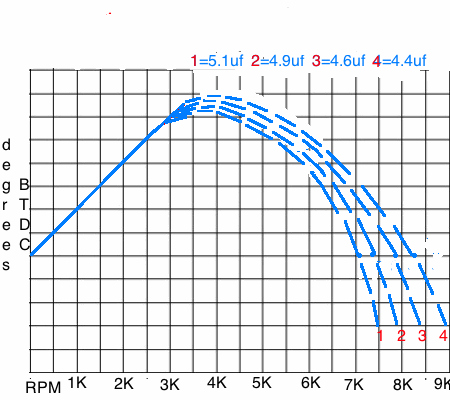Modifying the KDX CDII increased the 4.7uf timing cap by 1uf to 5.7uf and when I tested it I was really thrilled because it ran so good all the way through the rev range I couldn't believe it. But this was with a rewound stator coil which produced different voltage than a stock coil. Later I changed the coil to an OEM coil and changed the CDI's pull-down resistor to increase the negative voltage part of the waveform to where it needs to be for better performance. Seeing that it was designed as an enduro bike they probably made the curve so that the spark timing hinders upper mid range and top end performance for more reliability. After changing the curve, I had more of both mid range and top end power! I think it basically gave the mid range more spark advance, and the high revs more spark retard, both of which increases power on this bike (with ProCircuit pipe). An interesting twist to the story: I had a rewound stator coil on my bike up until I installed a stator coil from Elextrex in England. The OEM coil should have 304 - 456 ohms (avg 380) according to the manual. With a standard 1.5uf charge capacitor I calculate that a correct stator coil shouldn't have any more than 306 ohms to charge the capacitor fully at 9000 RPM. My locally rewound coil only had around 250 ohms which allows complete charge at peak RPM. The Electrex coil had 400 ohms which was too much. I think the rewound coil has wire that’s slightly thicker than OEM which would account for its lower resistance although the coil body is almost the same size as original. When I installed the Electrex coil my bike lost some of the top end power compared to how it was with the rewound coil. It just wasn’t impressive anymore. So I reinstalled the rewound coil and shazzam, the magic was back! I looked at the voltage waveform with my oscilloscope on the timing capacitor with the two stator coils while the engine was running. The Electrex coil produced more peak voltage at idle than the rewound coil. So with the Electrex coil the pull-down resistor would have to be lower in value to pull the voltage down to the stock levels. Someone on dirtrider.net said that when he installed a new stator coil from Electrex that the timing seemed more advanced and more prone to kicking back when he kickstarted it. That would make sense if the coil was putting out more voltage than the stock coil since that would advance the spark timing (the whole timing curve). When I received a new timing light (that is made to work with CDI ignitions) and put it to use on my KDX I saw that the timing progressively advances from idle all the way to maximum advance around 4000rpm and then starts retarding (going more toward TDC) more and more with higher revs. The following data is from my KDX with a rewound stator coil which affects the timing, but probably the same amount of degrees all the way thru the rpm range. But anyway this test does show the relative effects of timing cap change on the timing curve. 4.7uf is the standard value of the timing capacitor in the CDI. I added .5uf and 1uf to it for the following 3 values of timing cap. The readings (in degrees BTDC) under SR are from a standard CDI for my international version of street-ready KDX which uses a 4.7uf cap but a lower value of thermistor (which is in series with the cap and retards the timing). RPM 4.7uf 5.2uf 5.7uf SR ----------------------------- idle 19 19 19 17 3600 23 21.5 21 21 6000 19 19 18 19 Here is a graph showing the estimated curves for four different timing circuit capacitors.  Ideally I should of tested the timing at 9000rpm also but I didn't have the timing light that also reads the rpm. Instead I used a circuit and then a frequency meter which I had to the side and didn't want to hold the revs so high long enough to get a reading. Also it was hard to rev it to 9000 and keep it right there. I have experimented with using 5.2uf and on street runs I felt it gave me equal results. My international model (SR) was designed to have 21BTDC as the timing at 6000 rpm. I think all old KDX's are that way (probably pre-'90). So if you have a modern KDX with 19BTDC timing then you may have to advance the stator plate a couple degrees more. My final choice of timing capacitors on my CDI was a .47uf added to the base 4.4uf, totaling 4.9uf. This was better than the 5.2uf for the mid range. The final product was reliable (race tested) and gave a noticeable power increase all through the rev range. Try it, you'll like it! My email is a57ngel@yahoo.com More of my pages: SR mods, motocross mods, KIPS servicing, tire changing guide, alternative healing methods |